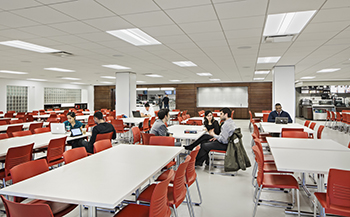Q&A: Designing Dining Halls for Today’s Students
 NEW YORK — Dining halls at university campuses nationwide are starting to evolve as students want healthier food choices and a more comfortable environment for lounging and socializing. With these considerations in mind, St. John’s University renovated its School of Law cafeteria in New York early last year.
NEW YORK — Dining halls at university campuses nationwide are starting to evolve as students want healthier food choices and a more comfortable environment for lounging and socializing. With these considerations in mind, St. John’s University renovated its School of Law cafeteria in New York early last year.
Designed by the New York office of Perkins+Will, the new 7,500-square-foot cafeteria features improved lighting and multipurpose seating areas that give the dining facility a more residential feel. School Construction News spoke with Joan Blumenfeld, FAIA, FIIDA, LEED AP, interior design leader in the architecture firm’s New York office, about the St. John’s cafeteria project and designing dining facilities for today’s students.
Q: What was the main goal of the St. John’s project?
Blumenfeld: The cafeteria hadn’t been updated in a number of years, and the way that food is served in an academic cafeteria has evolved and the kinds of food that are served are different. It really needed updating to match the way that students are expecting to eat and to be served healthier foods. Most of the work was done in the serving area, but we also freshened up the seating area.
Q: What are some of the key design elements involved?
Blumenfeld: First, we introduced some raw materials like wood and we also configured the cafeteria so that it can be used for large meetings. It kind of has a multipurpose function now. The servery has improved lighting, and we improved the lighting in the seating area. The lighting is energy efficient so there was also attention paid to that as well as a new color palette that was appropriate for the law school. Also, a small coffee bar was added that was new.
Q: What specifics do you have to consider when designing a dining hall?
Blumenfeld: The first thing is to work with the university and a kitchen consultant to figure out what the design goals are and what the functional goals are, improving the flow of how students move through the space. What is the program they want to have? What kind of food? A grab-n-go option was added, as well as more fresh food and salad options. A pizza oven was added because that’s really popular. We discussed where the trends are and how [the students] will be eating, what the flow of students is and how to avoid bottlenecks functionally in terms of how people move through the space, and how to design around all that that. We didn’t want lines that cross each other and backups to happen.
From a design point of view, we were trying to create an environment that’s warm and inviting and a bit more residential in feeling. As such, the seating area lighting is warmer. At the same time, you have to watch out for practical issues such as surfaces that won’t stain and can easily be cleaned. There’s also some flexibility in that the seating area can be more multipurpose, and there’s flexibility in terms of what’s being served. The facility has the ability to update the menus through the day because that’s electronic.
Q: What kind of student or staff feedback did you receive during the design process?
Blumenfeld: We met with reps from the law school and some people that represented the student population. A multidisciplinary committee who we met with gave us programming information and feedback on the design.
Q: What were some challenges that occurred on the project and how did you overcome those challenges?
Blumenfeld: I would say the challenge with academic projects, particularly ones like this, is getting the work done in the very narrow time that you have for construction. A lot of the work was done during the summer, and we had to be really careful about how we scheduled everything.
